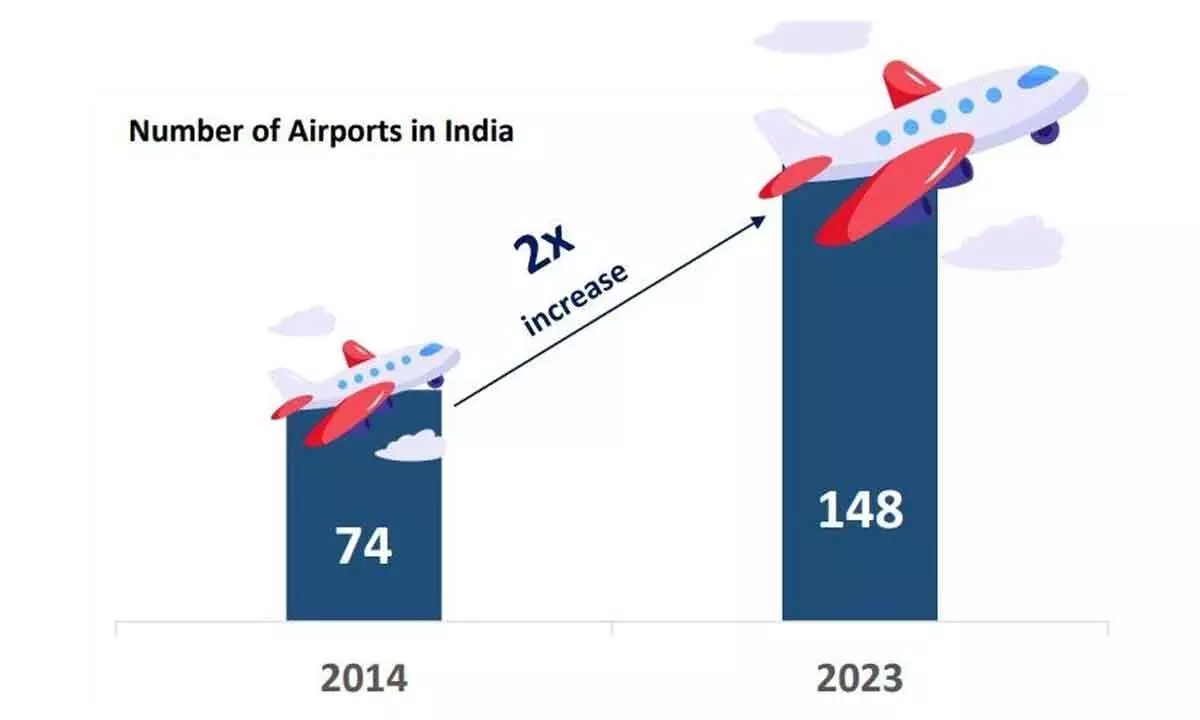Sustainability will be critical to Indian aviation and airports
Airports of the future will look different, thanks to energy sources like green hydrogen and SAF
image for illustrative purpose

The Cochin International Airport, which is fully powered by solar energy, has already carved a niche for itself as a global pioneer. The emphasis on solar power is not just about harnessing clean energy but also about catalysing a paradigm shift towards a greener aviation ecosystem
Aviation is invaluable for the planet’s socioeconomic development, and airports are in a unique position to support sustainable development. They help connect the world globally, yet they are very much a part of a city or a whole region. They contribute to the enrichment of people’s lives both locally and worldwide. However, they must also be mindful of our planet and the need to reduce our collective footprint. Airports have the dual obligations of maximizing the socioeconomic positives while minimizing environmental negatives. Similar to the rest of human endeavours, they must grow and recover sustainably, and look at every facet of their operations, to ensure that they are creating added value from a social, environmental, and economic standpoint.
Indeed, the three pillars of sustainability should be held at the forefront of all activities, as airports navigate their journey to recovery. From a social point of view, it is simply the right thing to do: businesses are responsible for taking care of their workforce and customers. Now more than ever before, their wellbeing is paramount. By providing a safe, healthy, fair, environmentally friendly and inclusive environment, as well as an efficient and positive customer experience, airports can retain public trust – a crucial element if they wish to prosper in the years ahead.
Airports of the future will certainly look different as new technologies emerge with alternative sources of energy such as green hydrogen and electricity, and sustainable aviation fuels (SAF). In this regard, ACI recently endorsed the World Economic Forum’s Clean Skies for Tomorrow 2030 Ambition Statement, which brings together a coalition that will accelerate the supply and use of SAF technologies.
As aviation remains a “hard to abate” sector in reducing Green House Gas (GHG) emissions, strong climate action from the industry is particularly important as travel begins to return to pre-pandemic levels. Accelerating the supply and use of SAF technologies to reach 10% of global jet aviation fuel supply by 2030 is a significant move to put the aviation industry on the path to net-zero emissions.
There are plans for an investment of $11 billion over the next five years to increase the number of airports in India to 200. Some of this will be funded by the Union government and there is a pro-active private investment. The Adani Group, intends to invest $ 7.2 billion in airport expansion across the eight airports the company operates, which includes the new Navi Mumbai airport that is expected to be operational next year. Once fully developed, this will provide capacity for an additional 90 million passengers annually.
Construction of another airport to serve the Delhi metropolitan area is underway with capacity for up to 70 million passengers, and the new Jewar Noida Airport is expected to open later this year. A further challenge will be ensuring that growth in the supporting infrastructure such as access roads and surface transport links matches pace with the planned airport developments.
India’s domestic passenger numbers are set to increase significantly in the coming years given the expected growth of the middle class and whilst airlines have put in place the long-term aircraft orders to support this growth, the key question is whether the current planned investment in airport infrastructure will keep pace and deliver what will be required.
Even as India’s aviation infrastructure is poised for expansion, with the number of airports projected to rise to 220 in the near future, the dedication to sustainable practices continues unwaveringly.
The ambition to establish over 90 carbon-neutral airports by 2024 reflects this commitment. The drive towards carbon neutrality is all-encompassing, extending from the macro objectives of infrastructural development to micro strategies such as electrifying ground support vehicles.
The Cochin International Airport, which is fully powered by solar energy, has already carved a niche for itself as a global pioneer. This stride towards renewable energy use is not an isolated one but part of a concerted effort by the government to ensure that all airports can meet their energy needs in an environmentally sustainable manner. The emphasis on solar power is not just about harnessing clean energy but also about catalysing a paradigm shift towards a greener aviation ecosystem.
These endeavours are not simply about reducing carbon footprints but redefining the fabric of India’s aviation industry. They reflect a paradigm where economic growth and environmental sustainability are not parallel paths but converge towards a singular vision of a sustainable future.
It is a narrative where airports are not just transit points but catalysts for eco-friendly development, embodying the ethos of a new India that aspires to grow responsibly.

